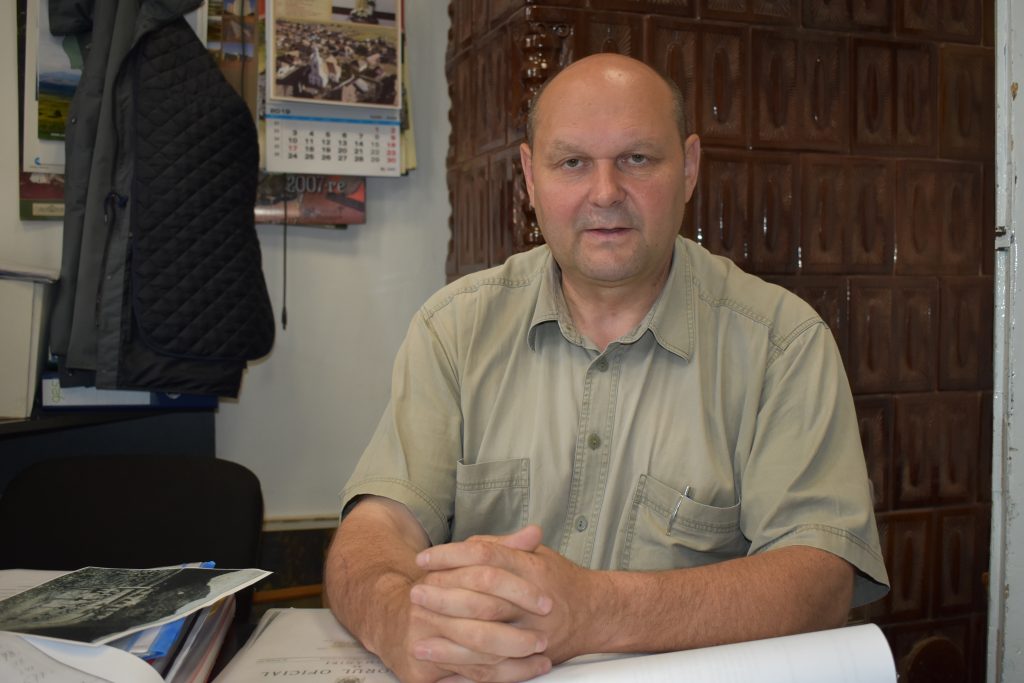This is the story of how an unsolved border dispute between two settlements (Csíkszentmárton / Sânmartin Ciuc and Dărmănești) turned abruptly for the worse when the mayor of Dărmănești took unilateral action based on questionable documents. It shows how ethnic conflict in the region can provoke tensions that then lead to irreversible impact on both the Hungarian and Romanian communities. The series of events also raises troubling questions about double standards in the Romanian judicial system. Read also Part I, Part III, Part IV and Part V.
ONCE delegation visits the Úz Valley graveyard
“I first heard about ONCE in 2015 when they asked for data about the military cemeteries administered by us, and they also reached out to other local authorities in other counties in this matter. They also reminded us that we need to administer these cemeteries and draw our attention to a celebration day, October 25, the Romanian Armed Forces Day, [Defence Minister’s Order from Oct. 10, 2005]. My answer was, that I firmly believe the graveyard is maintained and in good condition; we do our best to maintain its condition,” Gergely told Transylvania Now. Later that year, a delegation arrived in Csíkszentmárton and visited the two military graveyards administered by this local authority, including the Úz Valley site.

“When the delegation from ONCE visited the Úz Valley cemetery, I told them that it would be a good idea to visit Italy and Slovenia to see how fallen heroes are honored regardless of their ethnicity. Those people already ended the war, and they respect the military graveyards, regardless of the nationalities buried there, but it seems that here this isn’t the case. These cemeteries are maintained and in good condition. I have visited such places several times years ago, because this is a topic I am personally interested in, and when I saw these cemeteries, I felt that I couldn’t leave the Úz Valley graveyard in the condition it was left in during the communist era; the soldiers buried there need to be honored. A fallen soldier is not an enemy anymore,” Gergely added.
In a press release issued a few days after the tensions became so high in the Úz Valley, ONCE says the Darmanest city mayor violated the law by modifying the military graveyard without their approval. However, their position is that the Csíkszentmárton mayor also acted illegally when he restored the cemetery. “But when they were here in 2015, why didn’t they say so? Why didn’t they say this is illegal, and you should remove these crosses and everything we did in order to restore the cemetery to its original condition based on the documents we got? Instead, they said everything is alright, you did a nice job.” Transylvania Now has reached out to ONCE to get a copy of the report filed by the delegation and their findings. We will update the article as soon as we we hear back from ONCE.
The Romanian community starts talking about the rehabilitation of the military graveyards located in Szeklerland
In August 2017, at the Summer Camp of the Romanians living in Szeklerland organized yearly at Marosfő/Izvorul Muresului, the Romanian community starts talking about the “rehabilitation” the military graveyards in Szeklerland, which includes the Úz Valley cemetery.
No notable progress was made until 2018, when the Dărmănești local authority signs a partnership agreement with the Culture Ministry for the “Rehabilitation of the Úz Valley cemetery” and plans to finish the work during the centenary year of Romania (the country celebrated its 100th birthday in 2018). They receive a 65,000 RON grant for this, although the territory on which the graveyard stands is under dispute between the two settlements, raising questions about the legality and validity of the grant. Apparently, the city mayor and his team finds a way to get around this issue and initiate a process in which the Dărmănești local authority seeks to update its public goods registry. The inventory is finished at the end of December 2018.
Dărmănești finds a way to hijack the land where the cemetery sits from Csíkszentmárton
Since the border between the two settlements wasn’t clarified during the 2012 talks, the mayor of Dărmănești finds a way end the dispute by himself. In early October Dărmănești receives a reply from the Bacău Land Registry, which states the Úz Valley settlement belongs to the Romanian city.
“From our perspective, the Land Registry’s actions represent a series of illegalities, because it didn’t take into consideration law 2/1968. There is a document in which representatives of the Bacău and Harghita County’s land registry agree that the line of the river is clearer than the line of the forest, and defines the borders based on that. The main problem here is they did that without asking the local authorities (in this case us) about their position. Because we don’t agree with that and have proof backing us, we tried several times, and we continue to fight for our rights. Even now we have initiated a dialog with the Dărmănești settlement to finalize the border dispute,” Gergely said.
Apparently, the funds received from the Ministry of Culture aren’t enough for the rehabilitation process, so at the end of December 2018 the Dărmănești City Council supplements the grant with additional funds, so the total amount allocated for rehabilitating the Úz Valley cemetery reaches RON 235,000 (~€50,000). Based on the document it has from the Bacău Land Registry confirming ownership on the site, on December 17, the Dărmănești local authority issues a construction license which launches the modifications in the Úz Valley cemetery. A few days later, on December 19, the Dărmănești mayor’s office invites bids for the “Execution of an international cemetery memorial and 50 crosses for Romanian heroes” on the online platform for public bidding, SEAP.
Click here to read Part III.
Read also Part I, Part IV and Part V.
Title image: Wood vs. concrete in the Úz Valley cemetery. Photo: István Fekete/TransylvaniaNOW